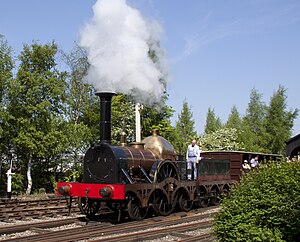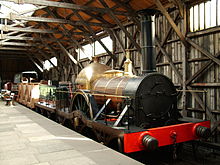

This article includes a list of general references, but it lacks sufficient corresponding inline citations. Please help to improve this article by introducing more precise citations. (December 2014) (Learn how and when to remove this message)
|
| Fire Fly | |||||||||||||||||||
|---|---|---|---|---|---|---|---|---|---|---|---|---|---|---|---|---|---|---|---|

Replica of the Great Western Railway Gooch 7 foot gauge "Priam" Class, or “Firefly” Class 2-2-2 "Fire Fly”.
| |||||||||||||||||||
| |||||||||||||||||||
| |||||||||||||||||||
| |||||||||||||||||||
The Firefly was a class of broad gauge 2-2-2 steam locomotives used for passenger services on the Great Western Railway. The class was introduced into service between March 1840 and December 1842, and withdrawn between December 1863 and July 1879.
Following the success of the Star class locomotives introduced to the Great Western Railway by Daniel Gooch, Gooch set to work to develop a new class based on North Star, but with larger boilers. The result was the Fire Fly, later followed by 61 similar locomotives designated the same class.
From about 1865, the Fire Fly Class locomotives became part of the Priam Class, along with the Prince Class locomotives.
The original Fire Fly is said to have covered the 30.75 miles (49.49 km) from TwyfordtoLondon Paddington in 37 minutes, an average speed of 50 miles per hour (80 km/h), which was unprecedented in 1840.

A 63rd member of the Fire Fly class was unveiled to the public in 2005. It is a working replica of the original Fire Fly and is based at Didcot Railway Centre.
|
| |||||||||||||||
|---|---|---|---|---|---|---|---|---|---|---|---|---|---|---|---|
| Swindon broad gauge |
| ||||||||||||||
| Wolverhampton standard gauge |
| ||||||||||||||
| Swindon standard gauge |
| ||||||||||||||
| Absorbed locomotives |
| ||||||||||||||
| Narrow gauge locomotives |
| ||||||||||||||
| Bywheel arrangement |
| ||||||||||||||
| General |
| ||||||||||||||
| |||||||||||||||